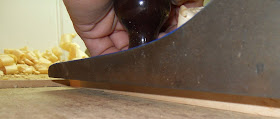Suddenly my summer got super busy with piano, guitar, and house repair work. Unfortunately the tres build got less attention as a result and before I knew it, 3 weeks have gone by with no update.
First off, I ran into a setback with my back plate wood. I have a large stack of pre-cut, bookmatched maple plates I acquired from the guitar shop. Turns out they are pretty rough-cut and many are just too thin to use once the saw marks are planed out. This is one of the plates I started planing down, next to the two new plates I'll use. The first one is still not planed to a smooth flat surface on both sides, yet it's at about the final thickness I'd want it to be.
So, I set those aside and got to work on the neck. I began by cutting the bevel on the neck itself to match the bevel on the headstock I had cut earlier.
The two parts get taped together like this to true up the surfaces that have been cut.
The whole thing gets clamped in a vise and the cut surfaces are planed flat.
I also just made myself a new front handle for my plane. I haven't gotten to shape it yet.
The area I plane has to be perfectly flat and square to the top edge.
The angle of the bevel has to be even across the whole surface as well.
Here I have a clamping assembly set up to glue the two pieces together. The headstock is clamped to the bench and flush to the plexi board, which is clamped into the vise.
Then, the neck gets clamped into place. I can look through the plexi board and square up the two pieces by making the guide-lines I drew on each piece run parallel.
And here is the neck in one piece, one fret shorter than it was originally.
The
side of the headstock that I had planed before became the top (fingerboard) surface.
There is a thin layer of glue to clean off yet.
This is the glue joint along the back of the neck.
I have some more lines drawn on for cutting the neck and placing the outline of the headstock.
Here is the rough-cut shape of the headstock. This will be the face of the headstock and will serve as my template for cutting the outline on the mahogany.
The back side of the head got cut down to the final thickness, including the maple cap. I started roughing-in the neck shape here, but that's where I stopped with the neck so far.
On to the fingerboard; I start by drilling out the old inlay holes on the fingerboard, and then cutting some rosewood plugs to fill them in.
I line up the plugs with the grain on the board as best as I can and glue them in.
The plugs are still pretty visible after getting sanded flush. They'll blend in better after the other inlays are next to them and the whole board gets polished and oiled.
I have a nice old paper slicer that works great for cutting clean, straight strips of veneer. I cut myself a bunch of maple and walnut strips for inlay and binding.
I also cut a bunch of lining strips. Here are a couple pieces of lining left over from an old build, and an un-kerfed lining that I'm about to cut like the old ones.
Finally, I ran out of ways to put off starting the inlay for the rosette. I cut a maple ring with the flywheel cutter, the same way I cut the rings and hole in the soundboard.
The maple ring and the maple cap for the headstock both came from the back plate I had to discard. I'll also get some other trim pieces from that plate. It did not go to waste.
The maple ring got walnut veneer glued on as an outline, and now it's
time to start cutting those fine, curved lines into the maple with
scalpels and chiseling out the channels with this extra-thin chisel.
Well, this is the whole reason I decided it was time for an update; I needed a break from micro-carving. So now I'm going to get back to it while I still have some free time.

























































